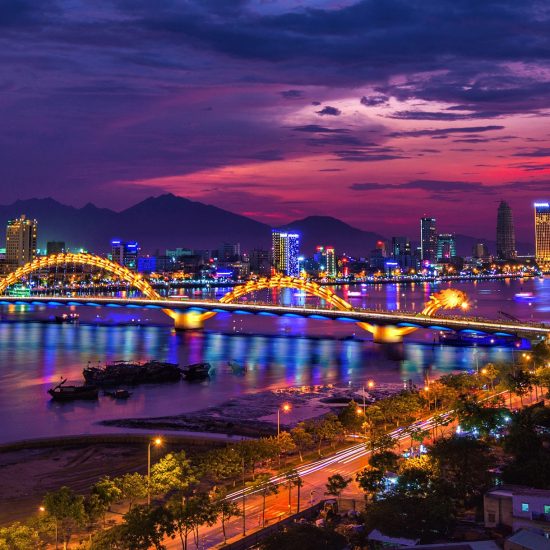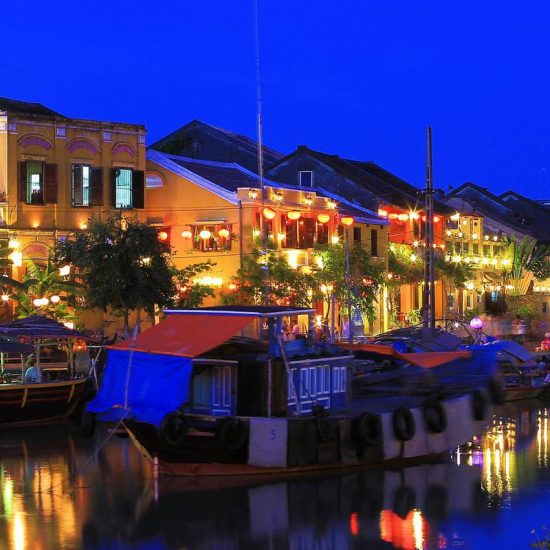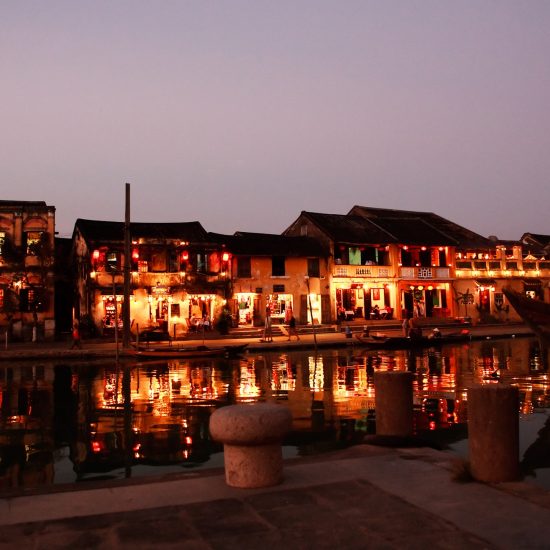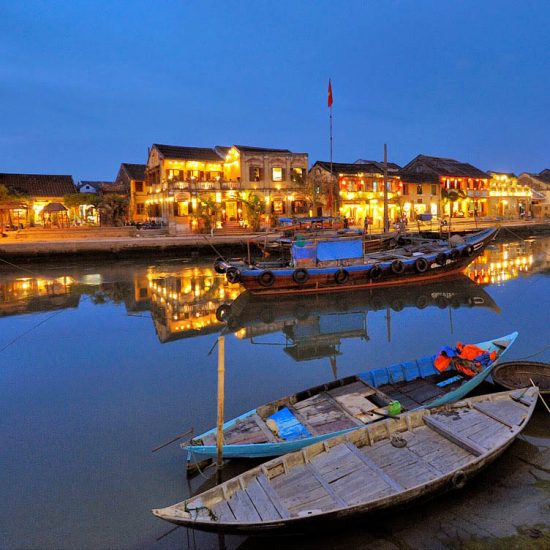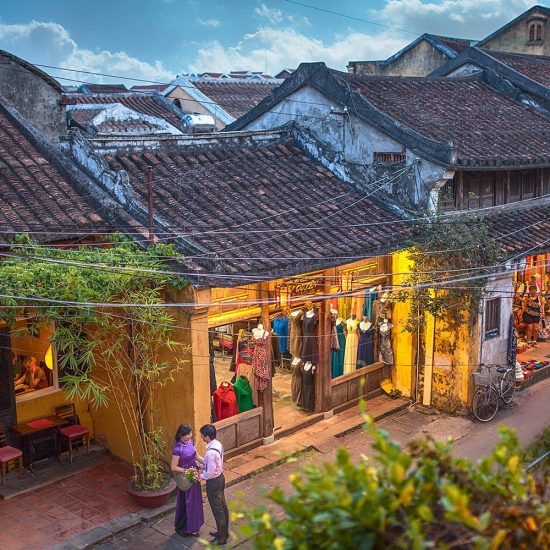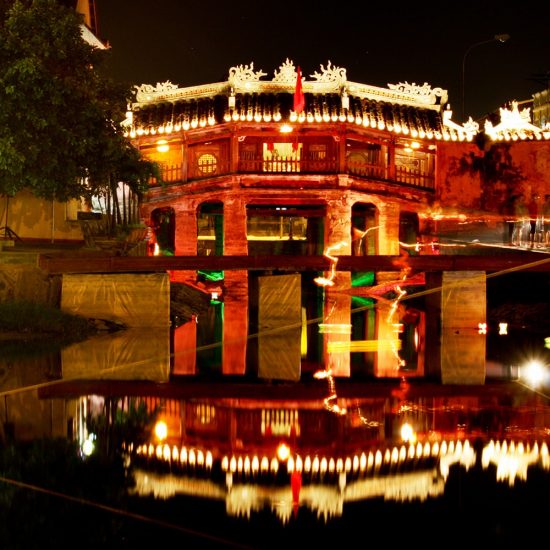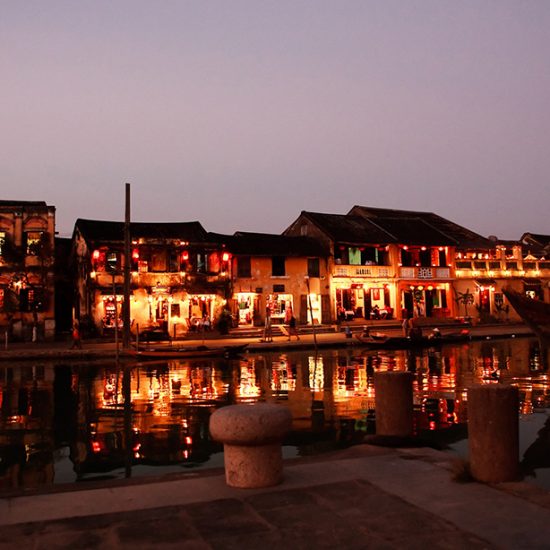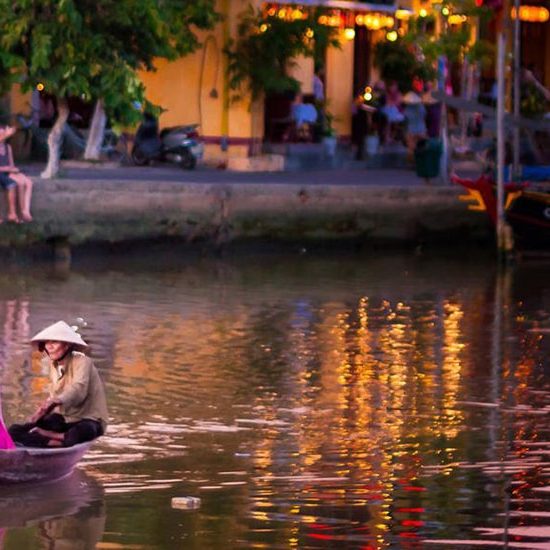Welcome to Hoi An
Graceful, historic Hoi An is Vietnam’s most atmospheric and delightful town. Once a major port, it boasts the grand architecture and beguiling riverside setting that befits its heritage, and the 21st-century curses of traffic and pollution are almost entirely absent.
The face of the Old Town has preserved its incredible legacy of tottering Japanese merchant houses, Chinese temples and ancient tea warehouses – though, of course, residents and rice fields have been gradually replaced by tourist businesses. Lounge bars, boutique hotels, travel agents and a glut of tailor shops are very much part of the scene here. And yet, down by the market and over on Cam Nam Island, you’ll find life has changed little. Travel a few kilometres further – you’ll find some superb bicycle, motorbike and boat trips – and some of central Vietnam’s most enticingly laid-back scenery and beaches are within easy reach.
Table of Contents
1.1 Sights
1.1.1 Hoi An Houses: A Closer Look
The historic buildings of Hoi An not only survived the 20th century’s wars, they also retained features of traditional architecture rarely seen today. As they have been for centuries, some shopfronts are shuttered at night with horizontal planks inserted into grooves that cut into the columns that support the roof.
Some roofs are made up of thousands of brick-coloured am and duong(yin and yang) roof tiles – so called because of the way the alternating rows of concave and convex tiles fit snugly together. During the rainy season the lichens and moss that live on the tiles spring to life, turning entire rooftops bright green.
A number of Hoi An’s houses have round pieces of wood with an am–duong symbol in the middle surrounded by a spiral design over the doorway. These mat cua (door eyes) are supposed to protect the residents from harm.
Hoi An’s historic structures are gradually being sensitively restored. Strict rules govern the colour that houses can be painted and the signs that can be used.
It’s not just individual buildings that have survived – it’s whole streetscapes. This is particularly true around Ð Tran Phu and waterside promenade Ð Bach Dang. In the former French quarter to the east of Cam Nam Bridge, there’s a whole block of colonnaded houses, painted in the mustard yellow typical of French colonial buildings.
1.1.2 Worth a Trip: Thanh Ha
This small village has long been known for its pottery industry. Most villagers have switched from making bricks and tiles to making pots and souvenirs for tourist trades. The artisans employed in this painstaking work are happy just to show off their work, but prefer it if visitors buy something. There’s a 25,000d admission fee to the village.
Thanh Ha is 3km west of Hoi An and can be easily reached on bicycle.
1.1.3 Visiting the Co Tu
Living high in the mountains inland from Hoi An, the Co Tu people are one of the smallest, and most traditional minority groups in Vietnam. Their villages comprise of stilt houses set around a guol, a community building used for meetings, rituals and performances. Until quite recently, facial tattoos were common, and traditional dress is still worn when cultural performances are given for visitors. In the French and American Wars, the Co Tu were feared and respected fighters, and visitors often get to meet community legends who fought bravely against the Americans.
One Co Tu settlement, Bho Hoong, has developed a fine community tourism project allowing visitors to stay in the village. Co Tu guides have been trained and income is ploughed back into the area. Accommodation is in very comfortable bungalows with classy Asian decor and spacious bathrooms trimmed with bamboo and river stones.
Independent overnight stays can be booked via internet accommodation websites, and the village can also be visited on tours with Hoi An Jeep Adventures and Hoi An Motorbike Adventures. Two-day/one-night tours (per person from US$350) from Hoi An include meals and sightseeing around stunning scenery near the Lao border. Transport can be in a US jeep or an air-con car, and a longer three-day/two-night tours (per person from US$525) is also available.
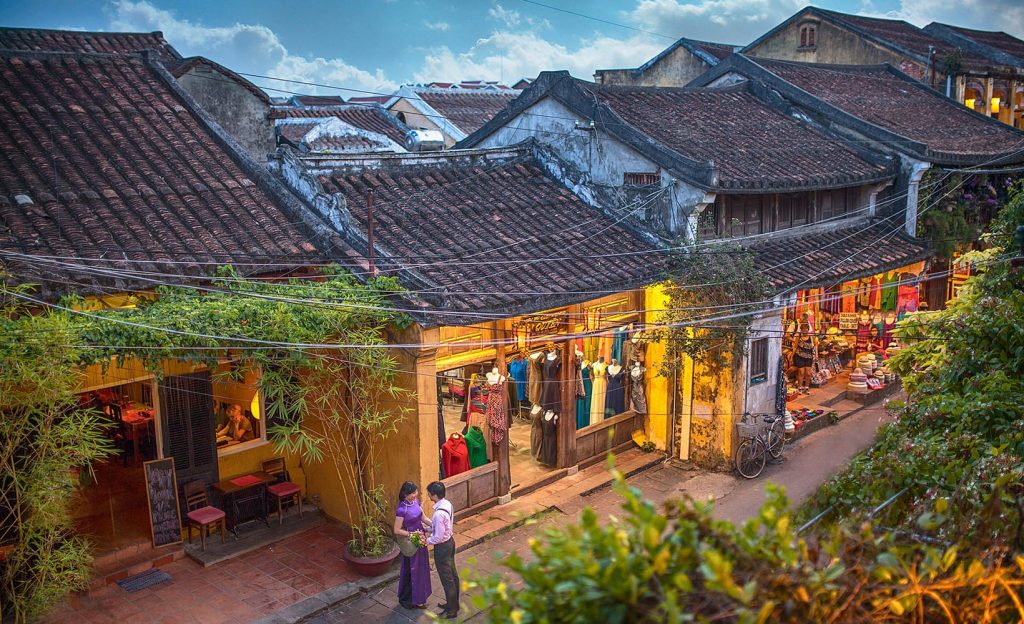
1. 2. Activities
2.1 Diving & Snorkelling
A trip to the Cham Islands is a superb excursion, and Hoi An’s two dive schools offer packages including overnight camping and diving trips. The diving is not world class, but can be intriguing.
A PADI Discover Scuba dive costs US$55 and two fun dives are US$80, while Open Water courses start at around US$375. Snorkelling costs around US$40, including gear, with an overnight beach camping option adding another US$40.
It’s usually only possible to dive or snorkel between February and September; the best conditions and visibility are from June to August.
2.2 Massage & Spa
There are many massage and treatment centres in Hoi An. Most are average, run by locals with minimal experience or training. A basic massage costs around US$12 an hour – there’s a strip along Ð Ba Trieu. At the other end of the scale are indulgent places that offer a wonderful spa experience (with prices to match); these are mostly based in the luxury hotels.
1.3 Sleeping
Hoi An has good-value accommodation in all price categories. There are only a couple of hotels in the Old Town, but nightlife finishes early here so there is little need to be right in the middle of things when there are plenty of good sleeping options close by. The best places book up fast, so plan as far ahead as you can.
Where to Stay
Many budget and midrange places are spread out to the northwest around Ð Hai Ba Trung and Ð Ba Trieu. Pretty An Hoi Peninsula and Can Nam island are also very close to the Old Town. Many luxury hotels are a few kilometres from town, on the beach, but all offer shuttle-bus transfers. Another option is staying at An Bang beach.
1.4. Eating
The beauty of Hoi An is that you can snag a spectacular cheap meal at the central market and in casual eateries – or you can splash out on a fine-dining experience. Hoi An is also blessed with many international dining choices.
Central Vietnamese Cuisine
Central Vietnamese cuisine is arguably the nation’s most complex and flavoursome, combining fresh herbs (which are sourced from organic gardens close by) with culinary influences from centuries of links with China, Japan and Europe.
A Hoi An Taster
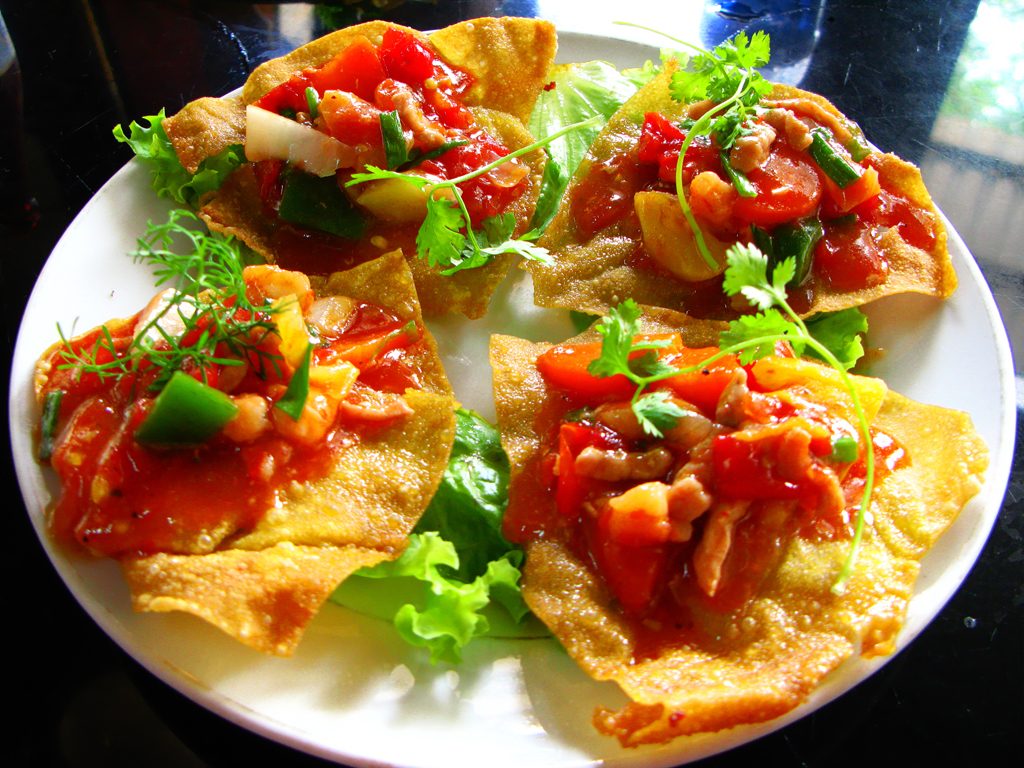
Hoanh thanh (wonton)
Hoi An is a culinary hotbed and there are some unique dishes you should be sure to sample.
‘White rose’ (banh vac) is an incredibly delicate, subtly flavoured shrimp dumpling topped with crispy onions. Banh bao is another steamed dumpling, this time with minced pork or chicken, onions, eggs and mushrooms, which is said to be derived from Chinese dim sum. Cao lauis an amazing dish: Japanese-style noodles seasoned with herbs, salad greens and bean sprouts, and served with slices of roast pork. Other local specialities are fried hoanh thanh (wonton) and banh xeo (crispy savoury pancakes rolled with herbs in fresh rice paper). Most restaurants serve these items, but quality varies widely.
1.5 Drinking & Nightlife
Hoi An is not a huge party town as the local authorities keep a fairly strict lid on late-night revelry; backstreets can be very dark after 10pm. The Old Town is a great place to treat yourself to a cocktail or glass of wine.
An Hoi
An Hoi, across the river from the Old Town, offers more raucous action. Happy hours keep costs down considerably, and most places close around 1am. The most popular spots in An Hoi change on a regular basis. Turn right after crossing the bridge from Hoi An, and you’ll soon see (and hear) where the backpacker action is currently happening along Ð Nguyen Phuc Chu.
1.6. Shopping
Hoi An has a history of flogging goods to international visitors, and today’s residents haven’t lost their commercial edge.
1.6.1 Clothes & Accessories
Clothes are the biggest shopping lure. Hoi An has long been known for fabric production, and tourist demand has swiftly shoehorned many tailor shops into the tiny Old Town. Shoes, also copied from Western designs, and supposed ‘leather’ goods are also popular but quality is variable.
1.6.2 Art & Craft
Hoi An has over a dozen art galleries; check out the streets near the Japanese Covered Bridge, along Ð Nguyen Thi Minh Khai. Woodcarvings are a local speciality: Cam Nam village and Cam Kim Island are the places to head for.
Ð Phan Boi Chau east of Ð Hoang Dieu is developing as an arts precinct with galleries and a crafts museum. Look for the free map reinforcing the street as a ‘Rue des Arts’ and showcasing the neighbourhood’s French colonial heritage.
1.6.3 Getting Clothes that Measure Up
Let’s face it: the tailor scene in Hoi An is out of control. The estimated number of tailors working here ranges anywhere from 300 to 500. Hotels and tour guides all have their preferred partners – ‘We give you good price’, they promise before shuttling you off to their aunt/cousin/in-law/neighbour (from whom they’ll earn a nice commission).
The first rule of thumb is that while you should always bargain and be comfortable with the price, you also get what you pay for. A tailor who quotes a price much lower than a competitor’s is probably cutting corners. Better tailors and better fabrics cost more, as do tighter deadlines.
Hoi An’s tailors are master copiers – show them a picture from a magazine, and they’ll whip up a near-identical outfit. The shop assistants also have catalogues of many styles.
It helps to know your fabrics and preferences, right down to details such as thread colour, linings and buttons. When buying silk, make sure it’s the real thing. The only real test is with a cigarette or match (synthetic fibres melt, silk burns). Similarly, don’t accept on face value that a fabric is 100% cotton or wool without giving it a good feel for the quality. Prices currently hover around US$25 for a man’s shirt, or US$50 for a cotton dress. If a suit costs around US$100, make sure the fabric and handiwork is up to scratch.
Although many travellers try to squeeze in a clothing order within a 48-hour sojourn, that doesn’t leave much time for fittings and alterations. Remember to check the seams of the finished garment; well-tailored garments have a second set of stitches that binds the edge, oversewing the fabric so fraying is impossible.
Shops can pack and ship orders to your home country. Although there are occasional reports of packages going astray or the wrong order arriving, the local post office’s service is good.
In such a crowded field, these are places we regularly hear good things about (in alphabetical order): A Dong Silk, Hoang Kim, Kimmy, and Yaly.
A few of Hoi An’s tailors have now also diversified into making shoes and bags. See the Friendly Shop for good work that is guaranteed.
2.1 Etiquette
- Meals When dining with Vietnamese people, it’s customary for the most senior diner to pay for everyone. It is still polite to offer to pay at least once.
- Homes Remove your shoes when entering a private house.
- Heads Don’t pat or touch an adult (or child) on the head.
- Feet Avoid pointing your feet at people or sacred objects (eg Buddhas).
2.2 History
The earliest evidence of human habitation here dates back 2200 years: excavated ceramic fragments are thought to belong to the late Iron Age Sa Huynh civilisation, which is related to the Dong Son culture of northern Vietnam. From the 2nd to the 10th centuries, this was a busy seaport of the Champa kingdom, and archaeologists have discovered the foundations of numerous Cham towers around Hoi An.
In 1307 the Cham king presented Quang Nam province as a gift when he married a Vietnamese princess. When his successor refused to recognise the deal, fighting broke out and chaos reigned for the next century. By the 15th century, peace was restored, allowing commerce to resume. During the next four centuries, Hoi An – known as Faifoo to Western traders – was one of Southeast Asia’s major ports. Chinese, Japanese, Dutch, Portuguese, Spanish, Indian, Filipino, Indonesian, Thai, French, British and American ships came to call, and the town’s warehouses teemed with treasures: high-grade silk, fabrics, paper, porcelain, areca nuts, pepper, Chinese medicines, elephant tusks, beeswax, mother-of-pearl and lacquer.
Chinese and Japanese traders left their mark on Hoi An. Both groups came in the spring, driven south by monsoon winds. They would stay in Hoi An until the summer, when southerly winds would blow them home. During their four-month sojourn in Hoi An, they rented waterfront houses for use as warehouses and living quarters. Some began leaving full-time agents in Hoi An to take care of their off-season business affairs.
The Japanese ceased coming to Hoi An after 1637 (when the Japanese government forbade contact with the outside world), but the Chinese lingered. The town’s Chinese assembly halls still play a special role for southern Vietnam’s ethnic Chinese, some of whom come from all over the region to participate in congregation-wide celebrations.
This was also the first place in Vietnam to be exposed to Christianity. Among the 17th-century missionary visitors was Alexandre de Rhodes, who devised the Latin-based quoc ngu script for the Vietnamese language.
Although Hoi An was almost completely destroyed during the Tay Son Rebellion, it was rebuilt and continued to be an important port until the late 19th century, when the Thu Bon River silted up. Danang (Tourane) took over as the region’s main port. Under French rule, Hoi An served as an administrative centre. It was virtually untouched in the American War, thanks to the cooperation of both sides.
Then in the 1990s, a tourism boom transformed the local economy. The town was declared a Unesco World Heritage site in 1999, and there are now very strict rules in place to safeguard the Old Town’s unique heritage.
Today Hoi An’s economy is booming, and at times the Old Town can struggle to contain the sheer number of visitors. Many accommodation options have opened around the town’s periphery, as Hoi An expands to the fulfil the ever-hungry tourism sector.
3.1 Getting Around
Boat
Boat trips on the Thu Bon River can be fascinating. A simple rowing boat (with rower) should cost about 100,000d per hour, and one hour is probably long enough. Some My Son tours include a return journey by boat back to central Hoi An.
Motorboats can be hired to visit handicraft and fishing villages for around 200,000d per hour. Boaters wait at the boat landing between the Cam Nam and An Hoi Bridges in central Hoi An.
Bus
The bus station, 1km west of the town centre, mainly covers local routes.
Taxi
Metered taxis are usually cheaper than xe om.
Hoi An Taxi Good local operators.
Mai Linh Local partners to a reliable Vietnam-wide company.
3.2. Flights & getting there
3.2.1 Air
The closest airport is 45 to 60 minutes away in Danang.
3.2.2 Bus
Most north–south bus services do not stop at Hoi An, as Hwy 1 passes 10km west of the town, but you can head for the town of Vinh Dien and flag down a bus there.
More convenient open-tour buses offer regular connections for Hue and Nha Trang.
For Danang (one hour), it is much more convenient to organise a bus (around 120,000d) to pick you up at your accommodation. Yellow buses to Danang (20,000d) leave from the northern bus station just off Ð Le Hong Phong, a 15-minute walk or 15,000d xe om from central Hoi An. Local bus drivers for Danang sometimes try to charge foreigners more, but the correct fare is posted by the door and it helps to have the correct change. Note the last bus back from Danang leaves around 6pm. Accommodation can book transfers to/from Danang airport and train station.
3.2.3 Car & Motorcycle
To get to Danang (30km), head north out of town and join up with Hwy 1, or head east to Cua Dai Beach and follow the Danang Beach coastal road. Motorbikes charge about 180,000d for the trip to Danang. Taxis cost approximately 400,000d and are cheaper if you don’t use the meter. Negotiate a price first.
A trip in a car to Hue starts from US$100 (depending on how many stops you plan to make along the way), while a half-day trip around the surrounding area, including My Son, is around US$60.
A popular way to transfer between Hoi An and Hue is on a motorcycle. A bike with driver is around US$45, and around US$25 if you’re driving.
Roadtrippers Vietnam offers jeep transfers from Hoi An to Hue – and vice versa – taking in the Hai Van Pass, and lunch and beach stops along the way. Prices include hotel pick-up and drop-off.




